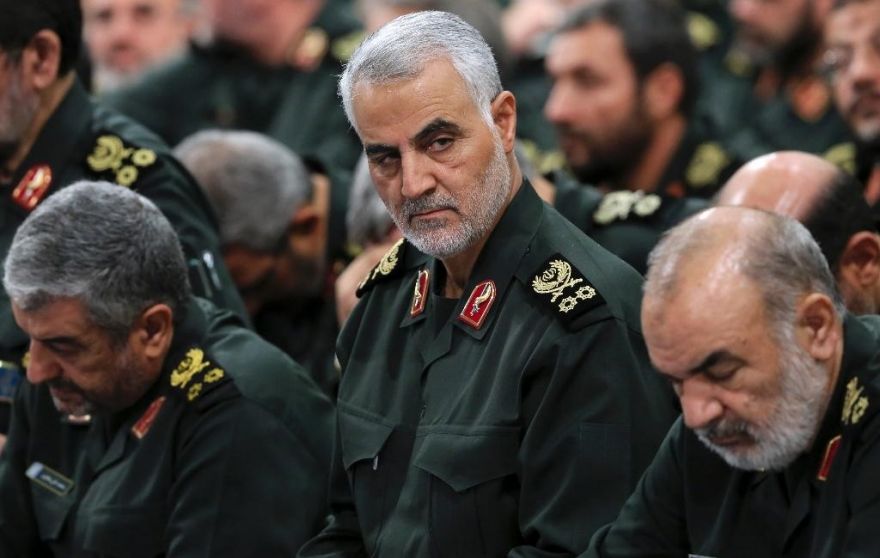From The Tower, Issue 49 (Apr-May 2017), by Shlomo Bolts & Mohammed A. Ghanem:
Iran and its allied militias are tearing through Syria on behalf of Assad’s ruthless regime, leaving corpses and chaos in their wake. Will the world ever hold them to account?
On the night of April 6, 2017, U.S. President Donald Trump signaled a radical shift in America’s policy towards the six year-old Syrian civil war by ordering multiple airstrikes against the Al Shayrat airbase near the city of Homs. Two days earlier, the airfield had been used by Bashar al Assad’s regime to launch a horrifying chemical weapons strike against the town of Khan Sheikhnoun, in which more than 80 people were murdered and hundreds more severely wounded. Reportedly, the nerve agent used in that attack was sarin – giving the lie to former Secretary of State John Kerry’s confident assertion, on NBC’s ‘Meet the Press’ in July 2014: “With respect to Syria, we struck a deal where we got 100 percent of the chemical weapons out.”
Whether Trump’s gambit will lead to the removal of Assad remains an open question. The stakes are certainly high, since the American airstrikes were not just a blow against Assad himself, but against his Russian and Iranian allies – the two outside powers that had secured, so went the conventional wisdom, his long-term survival through the brutal conquest of the northern city of Aleppo in December 2016. Five months on, the tyrant looks decidedly more insecure, now that he is in the sights of the world’s most powerful military.
The choice of Al Shayrat as the target for the Tomahawk missile strikes dramatically highlights the regional and global dimensions of the Syrian conflict. Russian military personnel are based there, as part of the extensive military aid which Moscow provides to Assad – they received advance warning from the Pentagon that the strikes were imminent. The base has also served officers of the Iranian Revolutionary Guards Corps (IRGC), Assad’s principle backer, and the shock troops of Hezbollah, Iran’s Lebanese Shiite proxy. Geographically, the airbase lies in the portion of south-western Syria, extending into Lebanon, under the control of Hezbollah and the IRGC.
Al Shayrat also highlights a too-often ignored aspect of this war, and the focus of this article: that Iran and Hezbollah have carried out grave war crimes and crimes against humanity – strongly resembling the crimes committed by the terrorists of the Sunni ISIS – against the Syrian people on Assad’s behalf. These took place, as we document here, not only in Aleppo and its environs, but in locations like Homs City and Tel Kalakh – with Al Shayrat serving as a launchpad for the attacks.
The Iranian Revolutionary Guards Corps (IRGC) and its affiliated foreign fighters have long been the true drivers of Bashar al-Assad’s war against his own people.
When pro-regime forces launched an assault in 2013 on Homs, then the “Capital of the Syrian Revolution,” Hezbollah led the charge. When Free Syrian Army (FSA) rebels threatened the capital Damascus in March 2015, Iran-backed foreign fighters from Iraq, Afghanistan, and Lebanon beat them back. When the FSA along with Sunni Islamist factions launched an assault near Assad’s heartland of Latakia a few months later, Hezbollah stepped in to counter them. The horrific slaughter in Aleppo late last year was only made possible after the Iran-backed Iraqi Nujaba Movement, which mirrors Hezbollah ideologically and operationally, turned the tide in Assad’s favor.
Given the Assad regime’s history of fanning sectarian tensions and turning a blind eye to extremists, its claim to be running a “secular” model of government was always largely propaganda. But Iran-backed foreign fighters dispense with that pretense completely. As Phillip Smyth notes in “The Shiite Jihad in Syria,” Iran-backed foreign fighters in Syria are recruited with the stated purpose of defending Shiite Muslims and Shiite holy sites. Smyth also details how this recruitment is heavily linked to Shiite religious scholars who preach vilayet e-faqih, the ruling ideology of the Iranian regime, which holds that the only form of legitimate rule is that of Islamic jurists.
Political and operational ties between Iran and its foreign fighters in Syria are quite clear. Hezbollah leader Hassan Nasrallah stated openly in August 2016 that “Hezbollah’s budget—its salaries and expenditures, its food and drink, weapons and missiles—are from the In January 2016, Human Rights Watch reported that the IRGC recruited thousands of Afghanis to “defend Shia sacred sites” in Syria by offering various material incentives. And the spokesman for Nujaba said in 2015, “We are all the followers of [Iranian Supreme Leader Ayatollah Ali] Khamenei and will go and fight to defend the holy sites and Shiites everywhere.”
Furthermore, evidence suggests that Iranian oversight of its proxies in Syria extends to the highest levels. Only two months before Hezbollah began its assault on Homs in 2013, top IRGC commander Hassan Shateri was killed on the Syrian-Lebanese border. IRGC head General Qassem Suleimani appeared on the front lines of the crucial battle for Damascus in early 2015. Both the American Enterprise Institute and the Institute for the Study of War believe that, around this time, the IRGC took direct command of operations by its foreign proxies in Syria, allowing Iran to “implant military leadership over a base of irregular fighters that it organizes, funds, and equips.”...
 General Qassem Suleimani is the head of the IRGC’s Quds Force, the primary force supporting Syrian President Bashar al-Assad. Photo: Office of the Iranian Supreme Leader
Follow the link for a detailed account of many atrocities by Iran
General Qassem Suleimani is the head of the IRGC’s Quds Force, the primary force supporting Syrian President Bashar al-Assad. Photo: Office of the Iranian Supreme Leader
Follow the link for a detailed account of many atrocities by Iran


